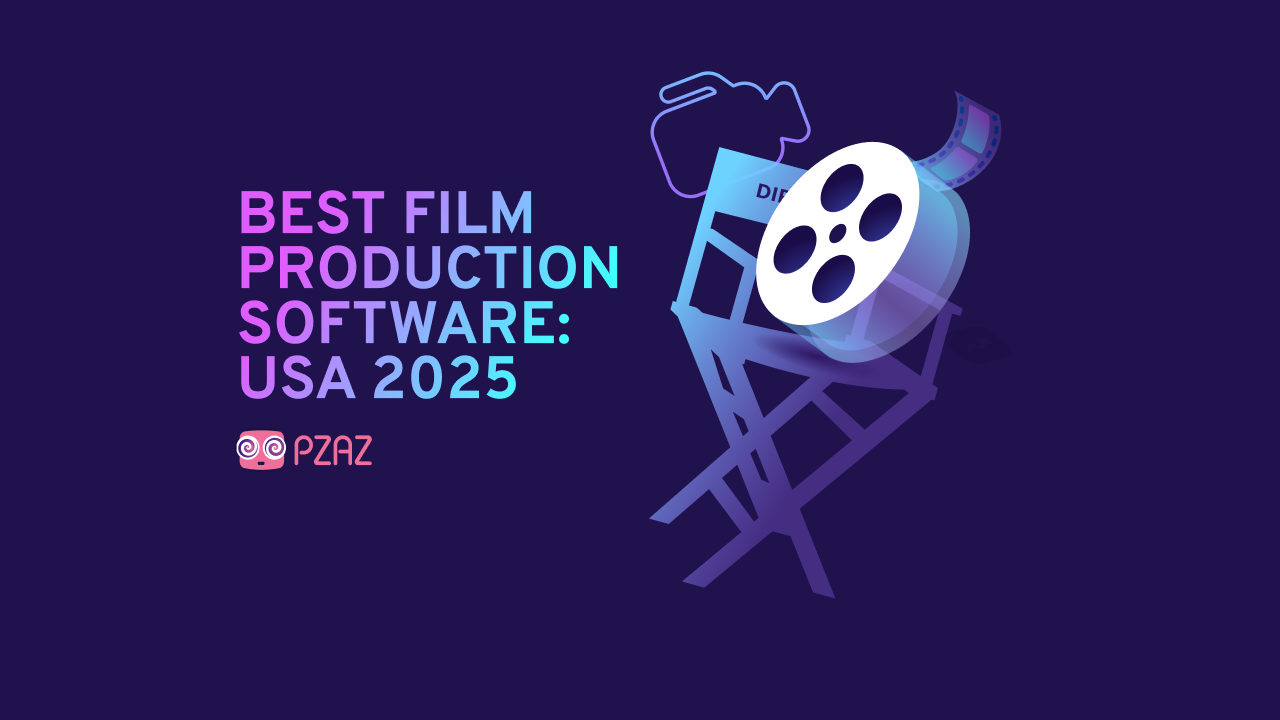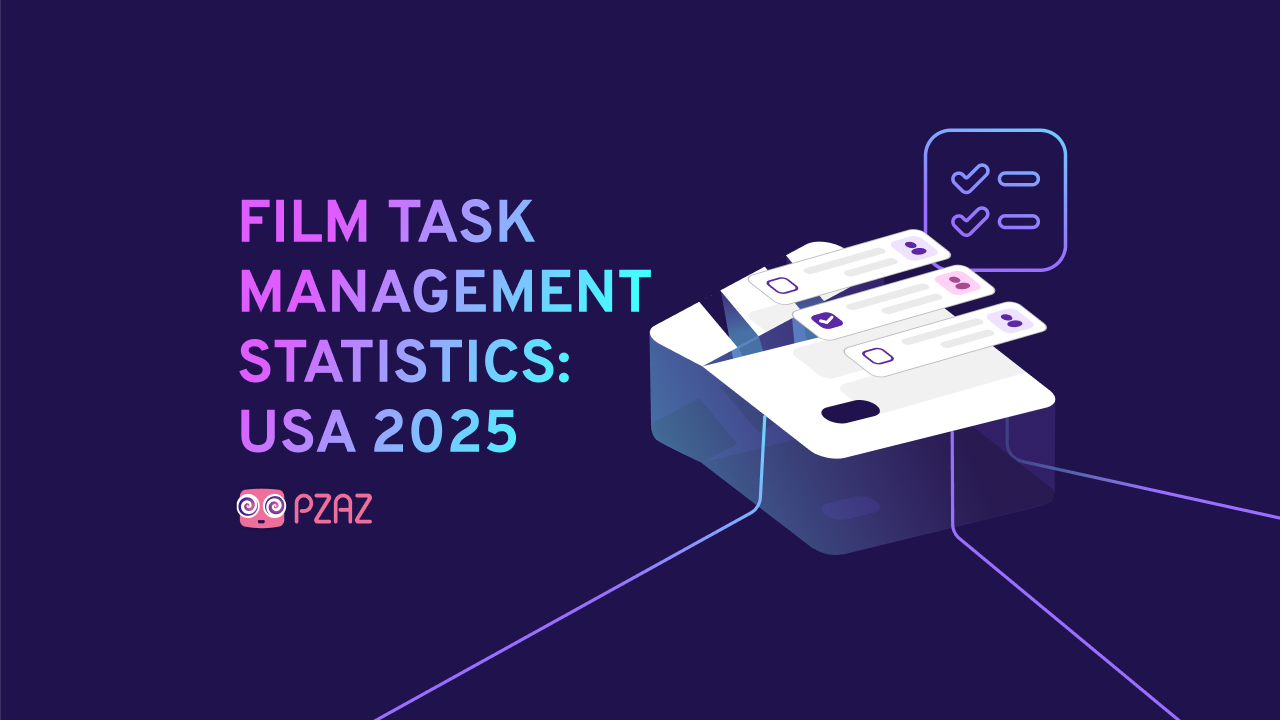Scriptwriting Software Best Practice Guide 2024
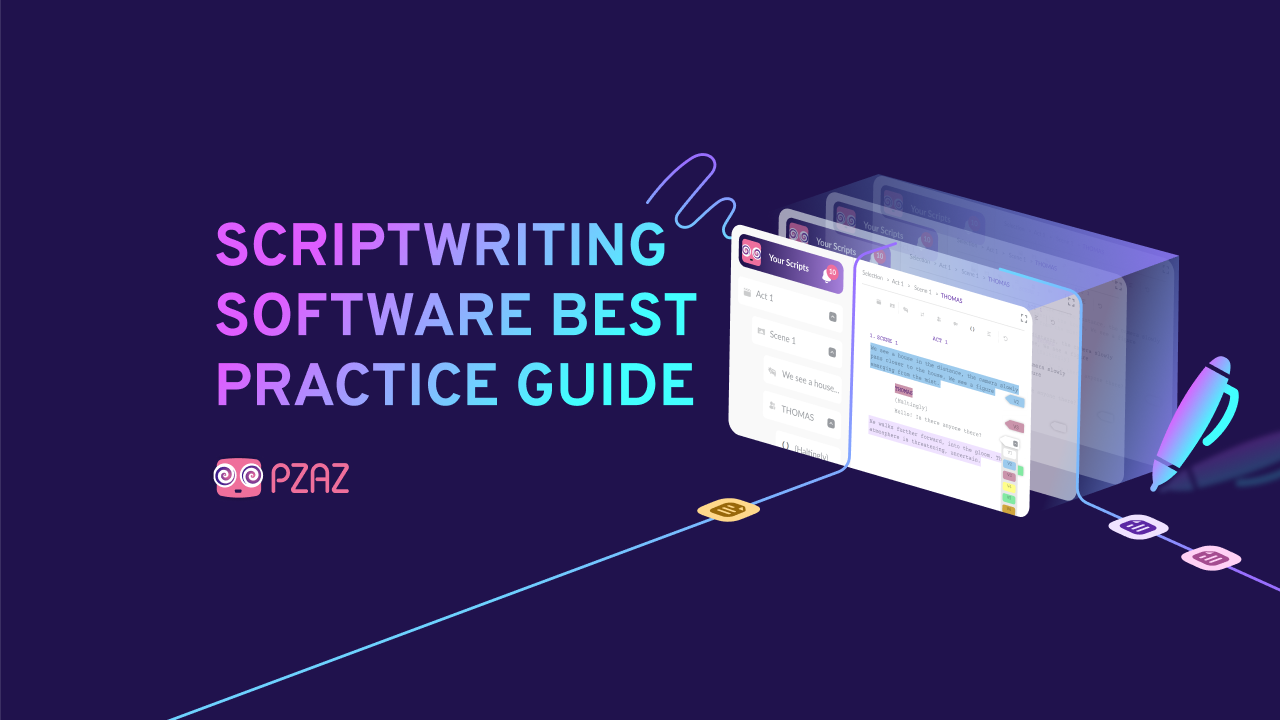
Introduction to Writing the Perfect Film, TV or Video Script
In the intricate dance of storytelling, where every word and punctuation mark can set the stage for cinematic magic, the choice of tools can elevate a script from good to unforgettable. Scriptwriting software has emerged as the silent protagonist in the narrative of filmmaking and writing, providing a backbone to the creative process. This digital maestro orchestrates the flow of ideas into structured screenplays, ensuring that the vision of writers reaches the screen in its most compelling form. This guide ventures into the heart of scriptwriting software, exploring its transformative role in both the writing and filmmaking industries. We will navigate through the essential features, review popular software options, discuss key considerations for making an informed choice, and share insights from those who have woven narratives using these tools.
The Importance of Scriptwriting Software
In the modern era of screenwriting, the significance of scriptwriting software cannot be overstated. It serves as more than just a writing tool; it is a comprehensive platform streamlining every aspect of script development. From the initial concept to the final draft, scriptwriting software ensures that writers can focus on creativity rather than the minutiae of formatting and version control. Its importance is twofold: enhancing individual productivity and facilitating seamless collaboration across the creative team.
Scriptwriting software simplifies the adherence to industry standards, automatically formatting dialogue, action, and scene headings, thus freeing writers to pour their energy into crafting compelling narratives. The revision tracking feature acts as a digital chronicle of the script’s evolution, capturing the journey of each line and scene. For projects involving multiple contributors, the collaborative features of scriptwriting software are indispensable. They allow real-time feedback, simultaneous editing, and a unified vision, despite geographical distances between team members. This collaborative capacity is crucial in an industry where timing and cohesion can make or break a project.
Features of Scriptwriting Software
Delving into the anatomy of scriptwriting software reveals a suite of features meticulously designed to cater to the nuanced needs of screenwriters:
- Auto-Formatting: This feature ensures that scripts meet industry standards without manual intervention, automatically aligning dialogue, scene headings, and action descriptions as per formatting norms.
- Revision Tracking: Keeping track of changes is vital in the script development process. Revision tracking allows writers and collaborators to see what changes were made, by whom, and when, providing a clear history of the script’s progression.
- Outlining Tools: These tools help writers organise their thoughts and plot structures, offering a visual roadmap of the narrative. They are essential for managing complex storylines and ensuring coherence across multiple acts or episodes.
- Collaboration Features: Modern scriptwriting demands flexibility and collaboration. Features that enable multiple users to work on a document simultaneously, leave comments, and share feedback in real time are crucial for dynamic team environments.
Popular Scriptwriting Software Options
The scriptwriting software landscape is rich and varied, offering tools that cater to every type of writer, from solo screenwriters to collaborative writing teams. Each software brings its own unique strengths to the table:
Final Draft
Final Draft is widely recognised as the industry gold standard in scriptwriting software. It offers a comprehensive feature set tailored for screenwriters, including advanced formatting options, a robust outlining tool, and seamless collaboration capabilities. Its widespread use across the film and television industry makes it a reliable choice for professionals seeking compatibility and standardisation.
Celtx
Celtx presents a cloud-based platform emphasising collaboration, making it ideal for teams. Beyond scriptwriting, Celtx offers a suite of pre-production planning tools, integrating the early stages of film and media production into one accessible platform. This makes it a versatile choice for projects that require extensive planning and team input from the outset.
Scrivener
Scrivener is not exclusively a scriptwriting tool but wins the hearts of writers with its extensive organising and research capabilities. It’s particularly favoured by writers handling complex narratives or adapting novels into screenplays, thanks to its ability to manage large amounts of text and its flexible structuring tools.
Fade In
Fade In is celebrated for its simplicity and affordability, offering a clean, distraction-free interface without skimping on the essential features needed for scriptwriting. It includes robust version control and format compatibility, making it a solid choice for new writers and seasoned professionals looking for a straightforward writing environment.
WriterDuet
WriterDuet is a browser-based scriptwriting software designed for real-time collaboration. It allows co-writing and editing, making it perfect for writing teams working remotely. Its focus on collaboration and accessibility makes it a popular choice for projects that evolve through team input.
StudioBinder
StudioBinder extends beyond traditional scriptwriting software by offering comprehensive production management tools alongside scriptwriting functionality. It caters to filmmakers and production teams looking to streamline the entire production process, from script to scheduling, shot lists, and call sheets. While its scriptwriting features may not be as deep as those of dedicated scriptwriting tools, its integrated approach to production planning makes it invaluable for projects looking for an all-in-one solution.
Each of these scriptwriting software options comes with its own set of benefits, designed to meet different needs and preferences. Whether you prioritise the depth of writing features, the ease of collaboration, affordability, or comprehensive production planning, there’s a tool out there that fits the bill.
Considerations for Choosing Scriptwriting Software
Selecting the right scriptwriting software requires a thoughtful evaluation of several factors:
- Compatibility: The software should seamlessly integrate with other tools used in the production process, ensuring smooth transitions between writing, editing, and production stages.
- Ease of Use: A user-friendly interface can significantly impact a writer’s efficiency. It’s important to choose software that aligns with your workflow and doesn’t hinder creativity.
- Cost: Budget constraints play a crucial role in decision-making. Consider both upfront costs and any ongoing subscription fees. Free trials or demo versions can offer valuable insights before committing.
- Platform Availability: Writers often work across multiple devices and operating systems. Cross-platform compatibility ensures that you can access and work on your scripts anytime, anywhere.
- Specific Features: Depending on the nature of the project, certain features might be more critical than others. Identify your non-negotiables, whether it’s advanced collaboration tools, extensive outlining capabilities, or comprehensive export options.
Benefits and Downsides for Each of These Tools
In the quest to bring stories to life, scriptwriters have a wealth of software options at their disposal, each with unique features tailored to different aspects of scriptwriting and production. This article explores the benefits and downsides of popular scriptwriting software, including a new addition to the list, StudioBinder, to help writers choose the tool that best fits their creative and logistical needs.
Final Draft

Benefits:
- Industry Standard: Its status as the preferred choice for professionals ensures wide acceptance and compatibility.
- Feature-Rich: Offers advanced formatting, outlining tools, and collaboration features, catering to all scriptwriting needs.
- Collaboration: Enables seamless collaboration with other industry professionals.
Downsides:
- Cost: The price tag can be steep for new writers or those on a budget.
- Complexity: The vast array of features may overwhelm newcomers.
Celtx
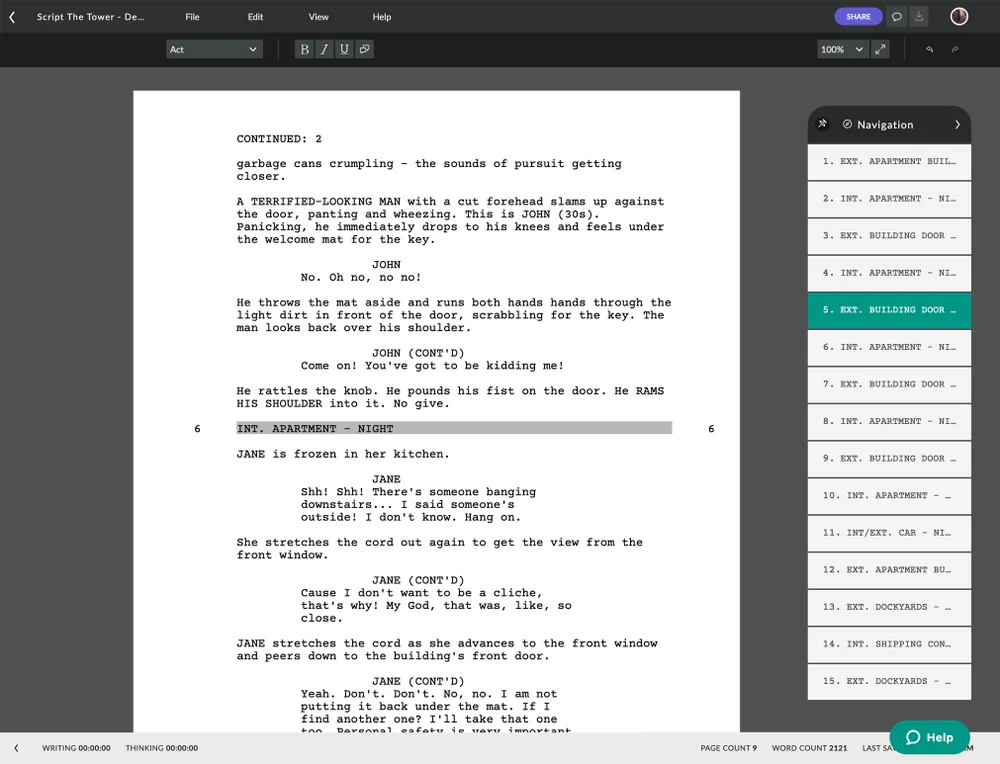
Benefits:
- Cloud-Based: Facilitates real-time collaboration and integrates scriptwriting with pre-production planning.
- All-in-One Platform: Provides tools for scriptwriting and all pre-production stages, making it versatile.
Downsides:
- Subscription Model: Ongoing costs can accumulate over time.
- Formatting Limitations: Some users find its formatting options less advanced than Final Draft’s.
Scrivener
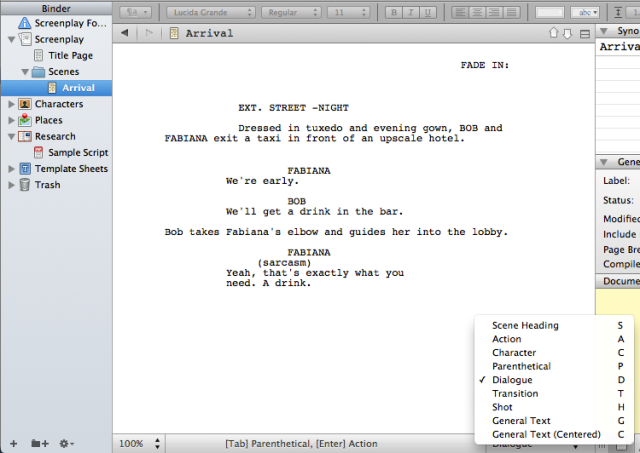
Benefits:
- Organisational Tools: Exceptional for managing complex narratives with its extensive organising and research capabilities.
- Value: Offers a lot of functionality at an affordable, one-time purchase price.
Downsides:
- Non-Specific: Primarily aimed at long-form writing, not exclusively scriptwriting.
- Learning Curve: The wide range of features can be daunting to master.
Fade In
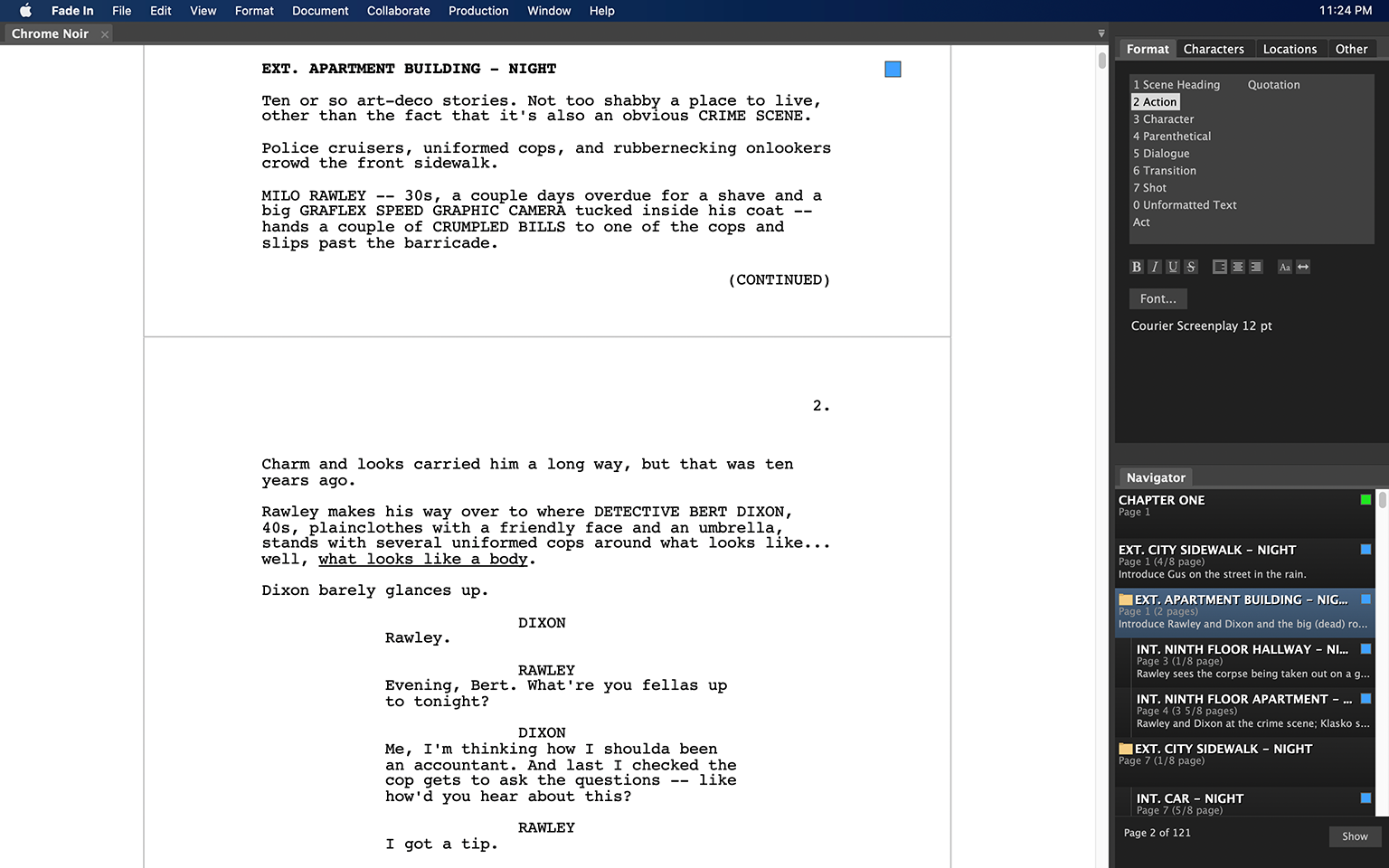
Benefits:
- Simplicity and Cost: Provides an easy-to-use interface and is more affordable than some alternatives.
- Robust Features: Despite its simplicity, it doesn’t compromise on necessary scriptwriting functionalities.
Downsides:
- Brand Recognition: Not as widely recognised or used as Final Draft.
- Collaboration Features: Less advanced compared to Celtx or WriterDuet.
WriterDuet
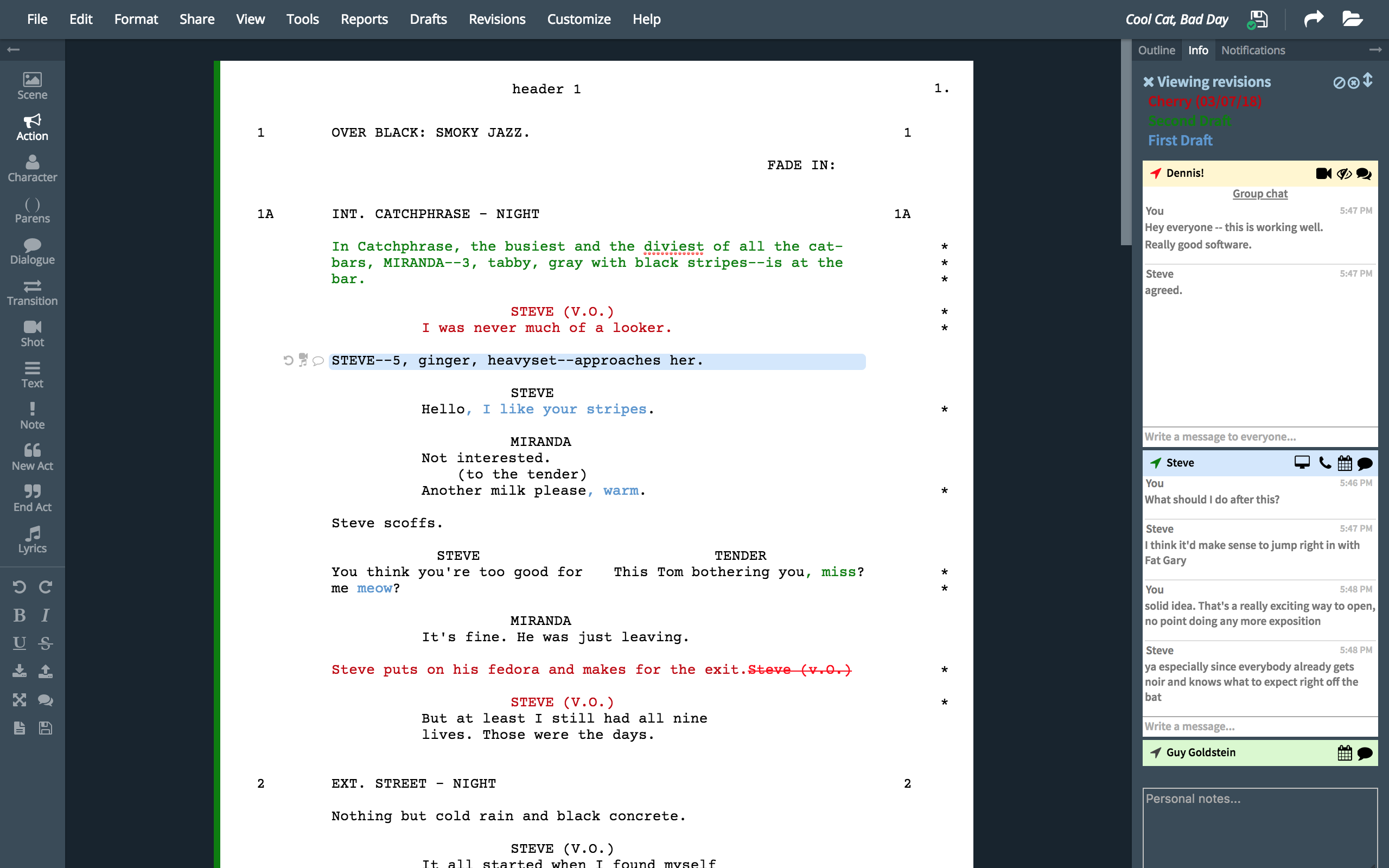
Benefits:
- Collaboration-Focused: Ideal for teams, allowing for real-time co-writing and editing.
- Accessibility: Browser-based access means you can write from anywhere with an internet connection.
Downsides:
- Internet Reliance: Primarily online use could be restrictive without a stable connection.
- Subscription Model: The free version is limited, and full features require a paid subscription.
StudioBinder
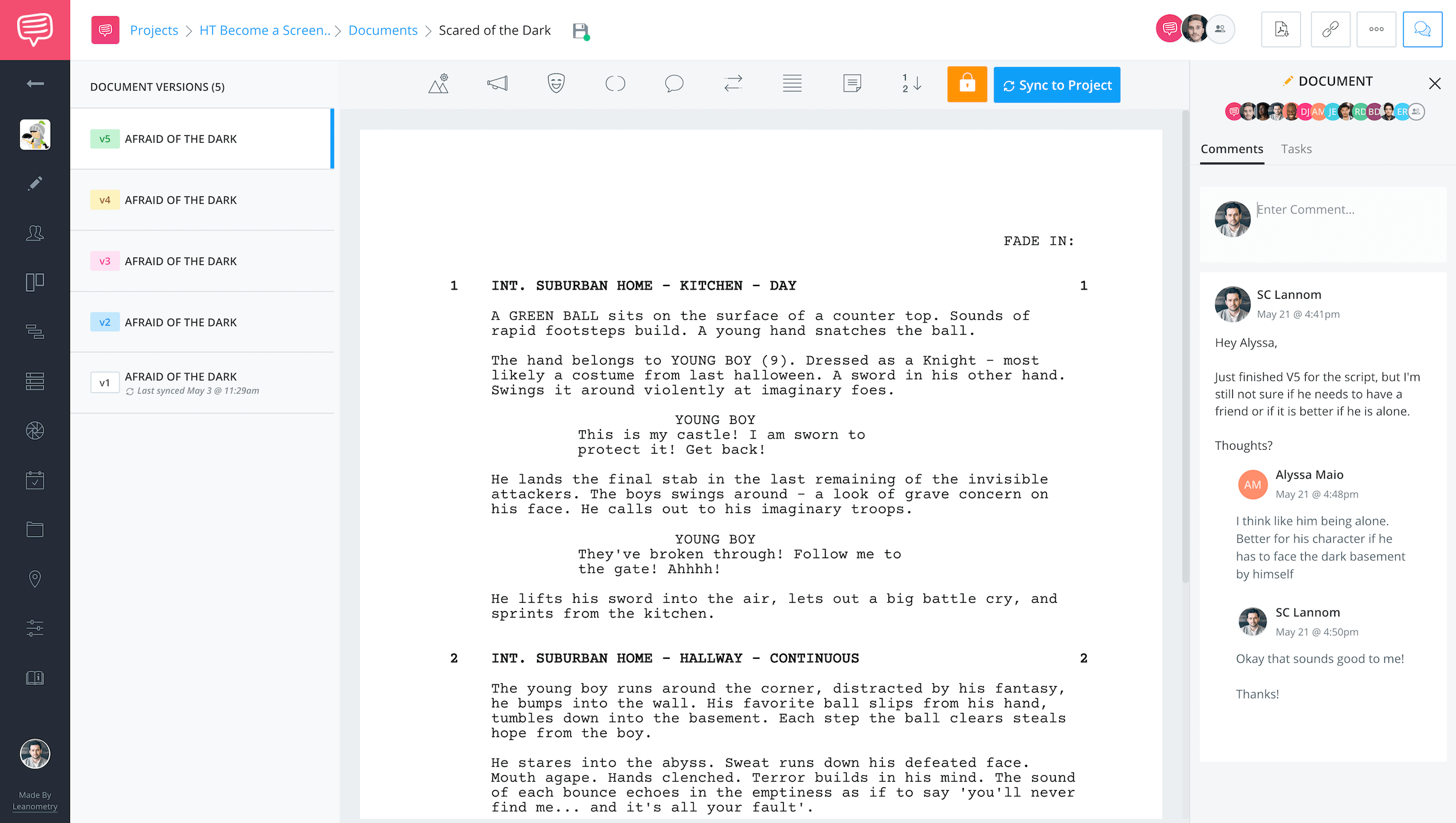
Benefits:
- Comprehensive Production Features: Beyond scriptwriting, StudioBinder offers extensive production planning tools, including scheduling, shot lists, and call sheets, making it a holistic platform for filmmakers.
- Collaboration and Organization: Streamlines communication and organisation for entire production teams, integrating script changes directly into the production workflow.
Downsides:
- Focus on Production: Offers scriptwriting capabilities, but its primary focus on production planning might mean its scriptwriting features are not as developed as those in dedicated scriptwriting software.
- Cost: The full suite of features comes at a premium, making it more suitable for professional production teams rather than individual writers on a budget.
In choosing the right scriptwriting software, it’s crucial to consider your specific needs, whether it’s deep scriptwriting features, collaboration, affordability, or comprehensive production planning. Each tool offers a unique blend of functionalities designed to support the script-to-screen process, and understanding these can help you make an informed decision that enhances your workflow and brings your stories to life more effectively.
Interim Case Study: A Fictional Insight into Scriptwriting Software Benefits
The proof of scriptwriting software’s impact lies in the stories of those who’ve wielded it to craft compelling narratives and we understand the value of real-world examples. However, due to challenges in obtaining a timely testimonial, we’ve created a hypothetical case study for illustrative purposes. This fabricated scenario aims to reflect potential benefits and scenarios of using such software, based on industry insights. Please note, this is a placeholder intended to provide conceptual understanding, and we plan to replace it with an actual case study in the future to offer genuine insights into the software’s practical application and impact on the scriptwriting process.
Introducing Pzaz: The Culmination of Scriptwriting Excellence
After extensive testing, experimentation, and collaboration with industry professionals, we recognised the need for a scriptwriting solution that not only addresses the current gaps but also elevates the creative process to unprecedented levels. This journey led to creating Pzaz, a tool meticulously designed to embody the ultimate scriptwriting experience. Our goal was to craft a seamless workflow that harmonises with the writer’s creativity, rather than interrupting or confining it. Pzaz stands as a testament to our commitment to enhance and support the creative process at every stage.
Pzaz was developed with a clear vision: to support the writer’s journey from the initial spark of inspiration through to the final stages of production and post-production. Unlike other tools, Pzaz is built on the understanding that the creative process is inherently fluid and dynamic. It respects the analogue workings of the brain, offering a platform where structure moulds itself around your ideas, not the other way around. This approach ensures that writers can maintain their creative flow without the constraints of rigid software architecture.
Furthermore, Pzaz addresses a crucial aspect of scriptwriting that many solutions overlook – the lifecycle of a script beyond the writing phase. It seamlessly integrates features for planning locations, managing elements, linking cast members, and tying into call sheets. This comprehensive functionality prepares the script for the collaborative and often complex stages of preparation, pre-production, production, and post-production. By facilitating easy access for alterations, edits, and additions by other team members, Pzaz ensures that the transition from script to screen is as smooth and efficient as possible.
In developing Pzaz, we worked closely with screenwriters, directors, and production teams to understand their needs and challenges. The result is a tool that not only supports but enhances the creative process, providing an intuitive interface that caters to the modern writer’s needs while preparing for the practicalities of bringing a story to life. Pzaz represents the next step in scriptwriting technology, offering a solution that is not just about writing but about creating an ecosystem where stories can flourish from conception to completion.
We invite writers and filmmakers to experience the difference with Pzaz – where your creative process is nurtured, supported, and realised in ways never before possible. Join us in embracing a future where scriptwriting is intuitive, integrated, and inspirational.
Final Reflections: Empowering Storytellers Through Scriptwriting Software
Scriptwriting software stands at the intersection of art and technology, offering a suite of tools that empower writers to bring their stories to the forefront with clarity, coherence, and creativity. In an industry where the written word is the blueprint for visual storytelling, choosing the right software is pivotal. It’s not merely about writing; it’s about crafting narratives that resonate, captivate, and ultimately, transcend the page to become cinematic realities. As we look ahead, the evolution of scriptwriting software promises to unlock the potential of storytellers further, shaping the future of filmmaking and writing in profound ways.
Best Film Production Software: USA 2025
Find out what filmmakers value most in their software tools, from editing support to progress tracking and post-production help, and learn why Pzaz is the ultimate creative partner in bringing your stories to life.
Film Task Management Statistics: USA 2025
Discover key film task management statistics from 1,063 independent US filmmakers in 2025. Learn how they handle deadlines, tools, team updates, and task dependencies to keep productions on track.

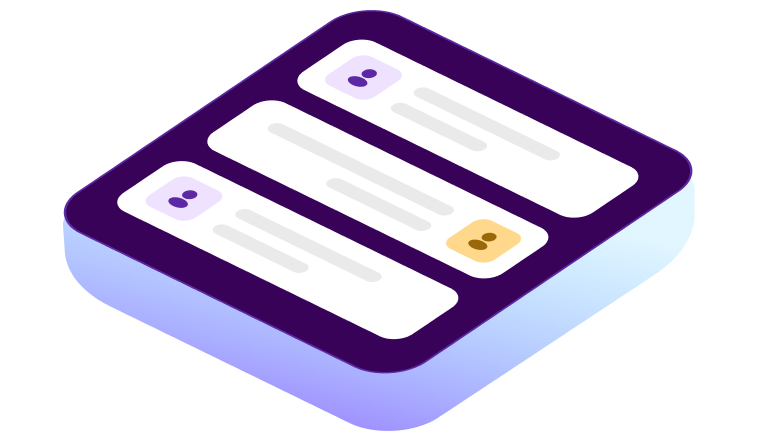 SCRIPTWRITING
SCRIPTWRITING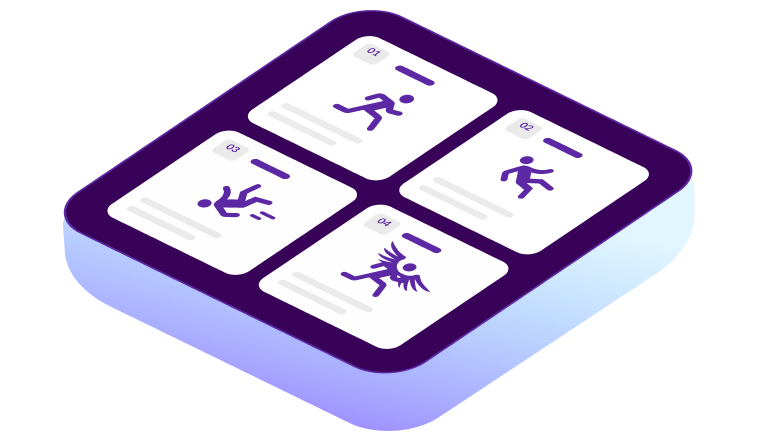 STORYBOARDING
STORYBOARDING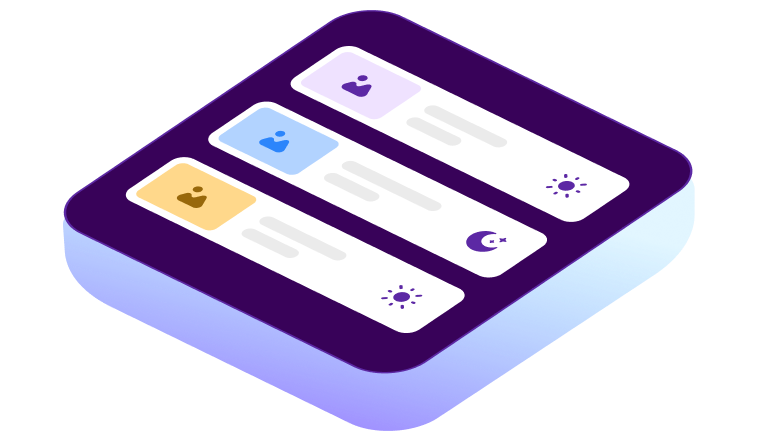 SCENE BREAKDOWN
SCENE BREAKDOWN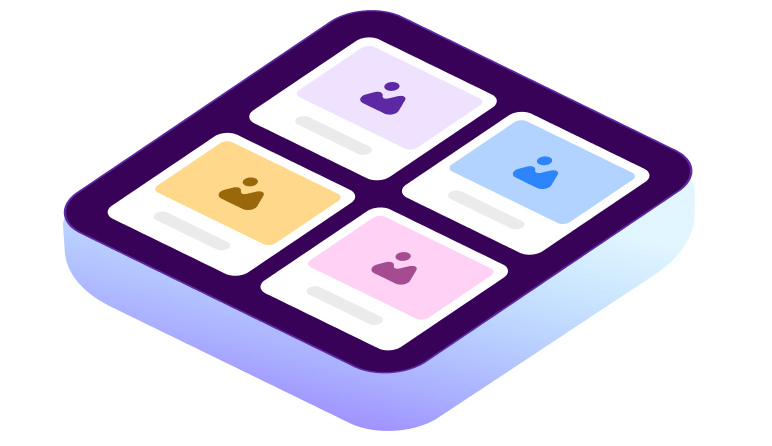 SHOT LIST CREATION
SHOT LIST CREATION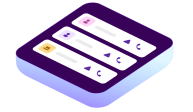 CREW & CAST MANAGEMENT
CREW & CAST MANAGEMENT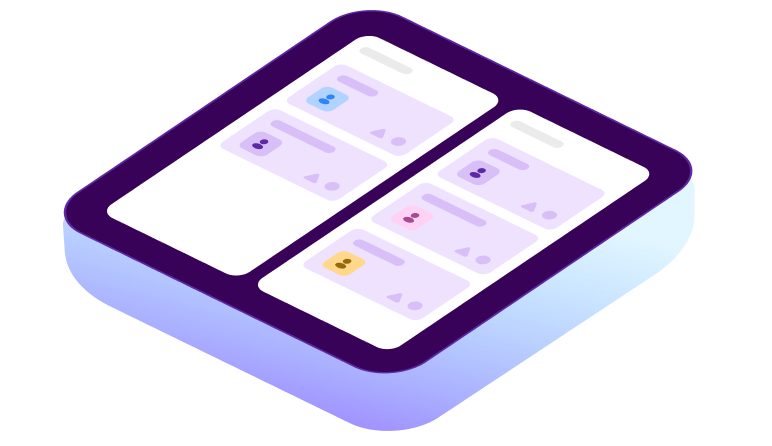 COLLABORATION TOOLS
COLLABORATION TOOLS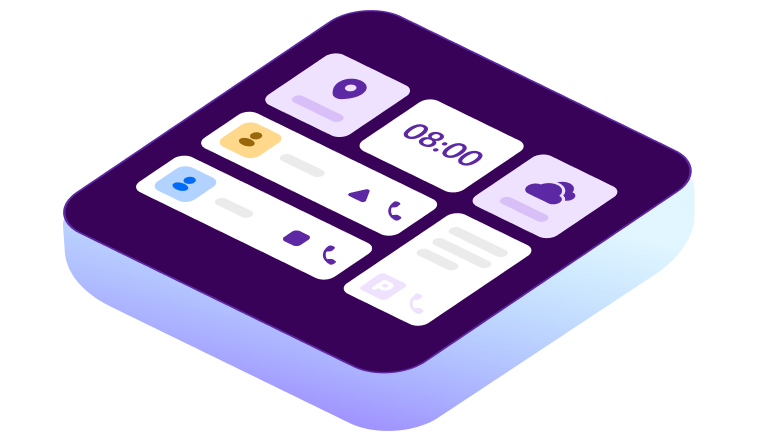 PRODUCTION & SCHEDULING
PRODUCTION & SCHEDULING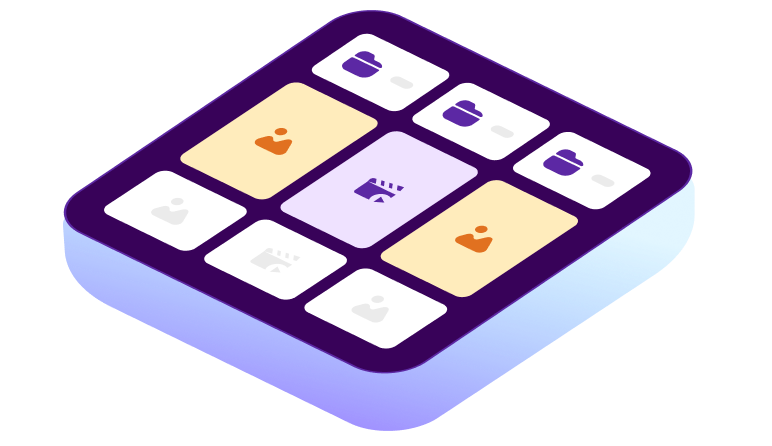 FILE SHARING & MEDIA STORAGE
FILE SHARING & MEDIA STORAGE